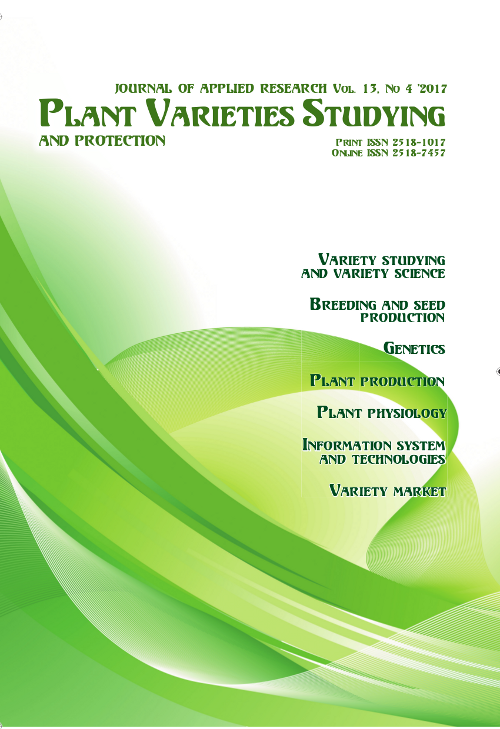Biochemical indices of lentil seeds depending on cultivation technology elements
DOI:
https://doi.org/10.21498/2518-1017.13.4.2017.117750Keywords:
lentil, sowing time, microfertilizers, growth regulators, biochemical indicesAbstract
Purpose. To investigate the effect of sowing time, microfertilizers and growth regulators on biochemical indices of lentil seeds.
Methods. Field and laboratory ones.
Results. Biochemical indices of lentil seed quality are given depending on the influence of sowing time, microfertilizers, growth regulators and their combination. Various factors affected the formation of biochemical indices of lentil seeds. Over the years of investigation, the content of crude fiber on the average was 3.2–3.3% for the control, the maximum value reached 6.9% in case of application of Reakom-SR-Bobovi + Regoplant during the first sowing time and 8.4% when applying Kvantum-Bobovi during the second sowing time. The Stimpo growth regulator influenced most of all on the starch content in the absolutely dry matter of seeds (56.5%) during the first sowing time and when it was combined with microfertilizer Kvantum-Bobovi (54.3%) during the second sowing time. On the whole, the content of crude protein in the lentil seeds of the ‘Linza’ variety was 26–28% over the years of investigation. In case of the combined application of microfertilizers and growth regulators (Reakom-SR-Bobovi + Stimpo), the protein content was 27.81% during the first sowing time and from 27.69% (Kvantum-Bobovi + Regoplant) to 28.60% (Reakom-SR-Bobovi) during the second sowing time.
Conclusions It was found that the maximum content of crude fiber were in versions with the application of microfertilizer Kvantum-Bobovi for plant nutrition in the bud-formation stage (4.5%) during the first sowing time and 10,8% during the second sowing time in 2016. The maximum content of starch in lentil seeds in 2016 during both sowing periods was 58,0 and 55,8% respectively in the version with the application of a growth regulator Stimpo in the bud-formation stage. In 2017, the highest indices were shown in the versions of Kvantum-Bobovi and Kvantum-Bobovi + Regoplant (55.1%) during the first sowing time and in the version of Reakom-SR-Bobovi (54.3%) during the second sowing time. The content of crude protein in lentil seeds in 2016 for Reakom-SR-Bobovi + Regoplant version was 27.92% during the first sowing time and for Reakom-SR-Bobovi + Stimpo version reached 29.93% during the second sowing time. In 2017, the above index was amounted to 28.21% for the Regoplant version during the first sowing time and 28.39% for the version of Kvantum-Bobovi during the second sowing time.
Downloads
References
Arsenova, L. Yu., Bondar, N. P., Usatiuk, S. I., & Dotsenko V. F. (2007). Investigation of changes in chemical composition of legumes seeds during germination and extrusion. Khranenie i pererabotka zerna [Grain Storage and Processing], 11, 49–52. [in Ukrainian]
Danylchenko, O. M. (2011). Influence of preplanting inoculation of seeds and different mineral backgrounds of mineral feeding on lentil photosynthetic productivity and yield. Vìsnik Sums’kogo nacìonal’nogo agrarnogo unìversitetu. Agronomìâ ì bìologìâ [Herald of Sumy National Agrarian University. Agronomy and Biology], 4, 94–97. [in Ukrainian]
Telezhenko, L. M., & Atanasova, V. V. (2010). Influence of lentil germination on the change of technological properties and chemical composition of the product. Kharchova nauka i tekhnolohiia [Food Science and Technology], 4, 70–72. [in Ukrainian]
Romanova, S. V., & Kovalov, S. V. (2009). The quantitative determination of Lens culinaris phenolic compounds. Visnyk farmatsii [News of pharmacy], 2, 24–26. [in Ukrainian]
Romanova, S. V., & Kovalоv, S. V. (2009). Study of amino acid composition of Lens culinaris M. Farmacevtichny chasopis [Pharmaceutical review], 4, 21–23. doi: 10.11603/2312-0967.2009.4.3017. [in Ukrainian]
Sukhova, H. I. (2013). Quality of lentil grain depending on the cultivation technology elements under the conditions of the Eastern Forest-Steppe zone of Ukraine. Visnik HNAY. Roslinnictvo, selekcia i nasinnictvo, plodoovocivnictvo [The Bulletin of Kharkiv National Agrarian University. Crop production, breeding and seed production, horticulture], 9, 265–269. [in Ukrainian]
Shevchenko, A. M., & Shevchenko, I. A. (2003). Sochevytsia – tsinna prodovolcha kultura [Lentil is a valuable food crop]. Luhansk: Znannia. [in Ukrainian]
Tkachyk, S. O. (Ed.). (2015). Metodyka derzhavnoi naukovo-tekhnichnoi ekspertyzy sortiv roslyn. Metody vyznachennia pokaznykiv yakosti produktsii roslynnytstva [Methodology of state scientific and technical examination of plant varieties. Methods of determining the quality indices of crop production]. Vinnytsia: Nilan-LTD. [in Ukrainian]
Downloads
Published
How to Cite
Issue
Section
License
Copyright (c) 2017 Ukrainian Institute for Plant Variety Examination

This work is licensed under a Creative Commons Attribution-ShareAlike 4.0 International License.
Starting in 2022, the copyright to the publication remains with the authors
Our journal abides by the CREATIVE COMMONS copyright rights and permissions for open access journals.
Authors, who are published in this journal, agree to the following conditions:
- The authors reserve the right to authorship of the work and pass the first publication right of this work to the journal under the terms of a Creative Commons Attribution License, which allows others to freely distribute the published research with the obligatory reference to the authors of the original work and the first publication of the work in this journal.
- The authors have the right to conclude separate supplement agreements that relate to non-exclusive work distribution in the form in which it has been published by the journal (for example, to upload the work to the online storage of the journal or publish it as part of a monograph), provided that the reference to the first publication of the work in this journal is included.

























 Ukrainian Institute for Plant Varieties Examination
Ukrainian Institute for Plant Varieties Examination  Селекційно-генетичний інститут
Селекційно-генетичний інститут Institute of Plant Physiology and Genetics of the National Academy of Sciences of Ukraine
Institute of Plant Physiology and Genetics of the National Academy of Sciences of Ukraine
 The National Academy of Agrarian Sciences of Ukraine
The National Academy of Agrarian Sciences of Ukraine